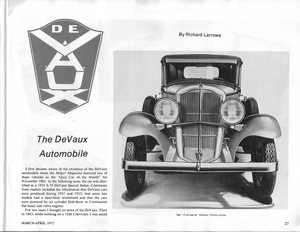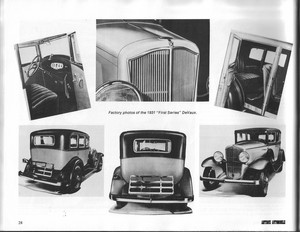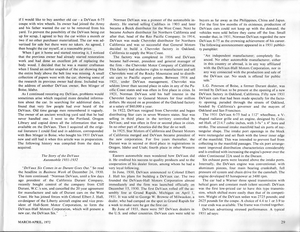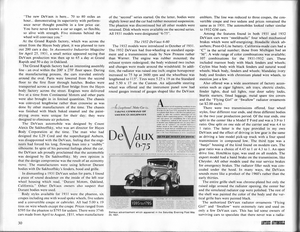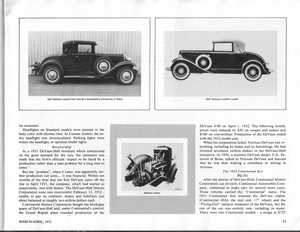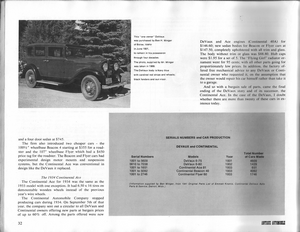|
By accessing or using The Crittenden Automotive Library™/CarsAndRacingStuff.com, you signify your agreement with the Terms of Use on our Legal Information page. Our Privacy Policy is also available there. |

The DeVaux Automobile
|
|---|
|
|
The DeVaux Automobile
Richard Larrowe
Antique Automobile
March-April 1972
I first became aware of the existence of the DeVaux automobile when the
Helper Magazine featured one of these vehicles as the "Quiz Car of the Month" for November 1961. In the following issue, the car as identified as a 1931 6-75 DeVaux Special Sedan. Comments from readers included the information that DeVaux cars were produced during 1931 and 1932; that some late models had a slant-back windshield and that the cars were powered by six cylinder Hall-Scott or Continental flat head, side valve engines.
For two years I thought no more of the DeVaux. Then in 1963, while working on a 1936 Chevrolet, I was asked if I would like to buy another old car - a DeVaux 6-75 coupe with wire wheels. Its owner had joined the Army and his father wanted the car to be removed from his yard. To prevent the possibility of the DeVaux being cut up for scrap, I agreed to buy the car within a month or two if no other purchaser materialized. The car was advertised for sale but there were no takers. As agreed, I then bought the car myself, at a reasonable price.
When I got home and started restoring it, I noticed that the previous owner had already started restoration work and had done an excellent job of replacing the body wood. I decided that he was a master craftsman when I found an earlier snapshot of the car showing that the entire body above the belt line was missing. A small collection of papers went with the car, showing some of the research its previous owner had done. Included was the address of another DeVaux owner, Ben Minger of Boise, Idaho.
As I continued restoring my DeVaux, problems would sometimes arise which required more detailed information about the car. In searching for additional data, I found that very few people had ever heard of the DeVaux. Old time garage men remembered it vaguely. The owner of an ancient wrecking yard said that he had never handled one. I went to the Portland, Oregon Library and copied down all the information that was available on the DeVaux. Then I acquired all the original literature I could find an in addition, corresponded with Ben Minger in Boise, who bought his 1931 DeVaux new and still had it when this article was in preparation. The following history was compiled from the data I acquired.
The Story of the DeVaux Automobile 1931-1932
"DeVaux Six Comes in as Durant Goes Out." So read the headline in
Business Week of December 24, 1930. The item continued: "Norman DeVaux, until a few days ago president of the California Durant Company, recently bought control of the company from Cliff Durant, W.C.'s son, and cancelled the 20-year agreement for manufacture and sale of Durant cars on the west coast. He has joined forces with Colonel Elbert J. Hall, co-designer of the Liberty aircraft engine and vice president of Hall-Scott Motor Corporation, to form the DeVaux-Hall Motors Corporation, which will present a new car, the DeVaux Six."
Norman DeVaux was a pioneer of the automobile industry. He started selling Cadillacs in 1903 and later became a Buick distributor for the West Coast. Next he became Auburn distributor for Northern California and after that, head of the the Reo Pacific Company. In 1914, DeVaux was made Chevrolet distributor for Northern California and was so successful that General Motors decided to build a Chevrolet factory in Oakland, California to supply the West Coast.
The factory was completed in 1916 and DeVaux became half-owner, president and general manager of the firm - Chevrolet Motor Company of California. This factory had exclusive rights to manufacture and sell Chevrolets west of the Rocky Mountains and to distribute cars to Pacific export points. Between 1916 and 1921, under DeVaux management, Chevrolet was seldom lower than second place in sales in any of the Pacific Coast states and was often in first place in cities. In 1921, Norman DeVaux sold his half interest in the Chevrolet factory to General Motors for four million dollars. He stayed on as president of the Oakland factory at a salary of $60,000 a year.
In 1922, DeVaux resigned from Chevrolet and began distributing Star cars in seven Western states. Star was selling in third place in the territory controlled by DeVaux; and was often in first or second place in cities. In no other part of America did the Star do so well.
In 1925, Star Motors of California and Durant Motors of California merged and DeVaux became president of the new corporation. For five years thereafter, the Durant was in second or third place in registrations in Oregon, Idaho and Utah; fourth place in other Western states.
Eastern automobile men wondered how DeVaux did it. He credited his success to quality products and to the cooperation of his dealer forces, among whom he had a very loyal following.
In June, 1930, DeVaux announced to Colonel Elbert J. Hall his plans for building a DeVaux car. The two founded the DeVaux-Hall Motors Corporation almost immediately and the firm was launched officially on December 15, 1930. The first DeVaux rolled off the assembly line at Grand Rapids, Michigan on April 1, 1931. It was sold to George W. Browne of Milwaukee, a dealer, who had camped on the spot in Grand Rapids for a week to make sure he got the first car.
By June of 1931, there were 587 DeVaux dealers in the U.S. and other countries. DeVaux cars were sold to buyers as far away as the Philippines, China and Japan. For the first few months of its existence, production of DeVaux cars could not keep up with the demand; the vehicles were sold before they came off the line. Small wonder that, in 1931, Norman DeVaux regarded the DeVaux 6-75 as the crowning achievement of his career. The following announcement appeared in a 1931 publicity pamphlet:
An independent manufacturer; completely financed. No other automobile manufacturer, either in this country or abroad, is in any way affiliated with the DeVaux-Hall Motors Corporation, nor in any way connected with the production and sale of the DeVaux car. No stock is offered for public sale."
L.G. Peterson of Boise, a former Durant dealer, was invited by DeVaux to be present at the opening of a new DeVaux factory in Oakland, California. Fifty new 1931 DeVaux cars that had been made specially for the factory opening, paraded through the streets of Oakland, headed by California'a governor and the mayors of Oakland and San Francisco.
The 1931 DeVaux 6-75 had a 112" wheelbase, a V-shaped radiator grille and an engine, designed by Colonel Hall, of 214.7 cubic inches, with 3-3/8" x 4" bore and stroke. The unusual intake manifold had six ports of rectangular shape. The intake port openings in the block were rectangular and set flush with the lower inner edge of the manifold. This was intended to prevent fuel from collecting in the manifold passages. The six port arrangement improved distribution characteristics considerably and is credited with increasing the engine's power over the older Continental 22A used in the Durant.
Six exhaust ports were located above the intake ports. Internally, the DeVaux engine was conventional, with aluminum pistons, four main bearing crankshaft, full pressure oil system and chain drive for the camshaft. The engine developed 65 horsepower at 3400 rpm.
The car had a Warner three speed transmission with helical gears and constant mesh (silent second). DeVaux was the first low-priced car to have this type transmission, which shifted more easily than that of its competitors. Weight of the DeVaux sedan was 2725 pounds; and 2625 pounds for the coupe. A choice of 4.4 to 1 or 3.9 to 1 rear ends was available. The frame was riveted together.
DeVaux advertising stressed performance. A typical 1931 ad says:
"The new DeVaux is here... 70 to 80 miles an hour... demonstrating superiority with performance never thought possible in a low price car. You have never know a car so eager, so flexible, so alive with strength. Five minutes behind the wheel will convince you."
At thee Grand Rapids factory, which was across the street from the Hayes body plant, it was planned to turn out 200 cars a day. In
Automotive Industries Magazine for April 25, 1931, a small notice appeared saying that DeVaux production was then up to 65 a day in Grand Rapids and 50 in Oakland.
The Grand Rapids factory had an interesting assembly line - an oval within the 200' x 270' floor space. During the manufacturing process, the cars traveled entirely around the oval. Parts were lowered from the second floor to the first floor through hatches. Bodies were transported across a second floor bridge from the Hayes body factory across the street. Engines were delivered five at a time from Continental Motors and other parts were also brought in in limited quantities. The chassis was conveyed lengthwise rather than crosswise as was done by other manufacturers of the time. The chassis was finished with black baked enamel and the paint-drying ovens were unique for their day; they were designed to eliminate air pollution.
The DeVaux automobile was designed by Count Alexis De Sakhnoffsky, who was an art director for Hayes Body Corporation at the time. The man who had designed the L29 Cord and the supercharged Auburn, was disappointed with the DeVaux, feeling that the engineers had forced his long, flowing lines into a "stubby" silhouette. In spite of his personal feelings about the car, the DeVaux ads proudly proclaimed that the automobile was designed by De Sakhnoffsky. My own opinion is that the design compromise was the result of an economy move. The manufacturers were using leftover Durant bodies with De Sakhnoffsky's fenders, hood and grille.
In dismantling a 1931 DeVaux sedan for parts, I found a piece of sound deadener on the inside of the left rear wheel housing which read, "Durant Motors, Oakland, California." Other DeVaux owners also suspect that Durant bodies were used.
Body styles available for the 1931 were the phaeton, six coupes including one with wood spoke wheels, five sedans and a convertible coupe or cabriolet. All had 5.00 x 19 tires on wire wheels except the coupe. Prices ranged from $595 for the phaeton to $795 for sedans. There were 3746 cars made from April to August, 1931, when manufacture of the "second" series started. On the latter, bodies were slightly lower and the car had rubber mounted suspension. The phaeton was discontinued but all other models were retained. Disk wheels were available on the second series. All 1931 models were designated "6-75".
The 1932 DeVaux 6-80
The 1932 models were introduced in October of 1931. The 1932 DeVaux had free-wheeling as standard equipment and a transmission made by New Process rather than Warner. The engine was rubber mounted; the exhaust system redesigned; the body widened two inches and changes were made around the windshield. In addition, the radiator was raised one inch; engine horsepower increased to 75 hp at 3600 rpm and the wheelbase was lengthened to 115". Tires were 5.25 x 19 on the Standard and 5.50 x 17 on the Custom. An adjustable steering wheel was offered and the instrument panel now had round gauges instead of gauges shaped like the DeVaux emblem. The line was reduced to three coupes, the convertible coupe and two sedans and prices remained the same as in 1931. The automobiles looked rather similar to 1932 GM cars.
Among the features found in both 1931 and 1932 DeVaux cars were "steeldraulic" four wheel mechanical brakes which were self-energizing; Houdaille shock absorbers; Prest-O-Lite battery. California-made cars had a "C" in the serial number; those from Michigan had an "M". A wide range of color combinations was available; 107 combinations for the 1931-1932 cars. These included maroon body with black fenders and wheels; Ceylon blue body with black fenders and natural wood wheels; black body, fenders and wheels; Mandalay ivory body and fenders with chromium plated wire wheels, to mention just a few.
Also offered was a wide assortment of factory accessories such as cigar lighters, ash trays, electric clocks, fender lights, dual tail lights, rear door safety locks, Startix starters, fitted luggage, metal spare tire covers and the "Flying Girl" or "Swallow" radiator ornaments (at $2.00 each).
There were two transmissions offered, four wheel styles, four different rear ends, and three different bodies in the two year production period. Of the rear ends, one split in the center like a Model T Ford and was a 3.9 to 1 ratio. One split on one side of the carrier and was 4.4 to 1 ratio. The latter is the type provided in my own DeVaux and the effect of driving in low gear is the same as driving a late model pick-up truck with a four speed transmission in compound low. He third type was a "banjo" housing of the kind found on modern cars. The gear ratio was a choice of 4.45 to 1 or 4.3 to 1. An open drive line, Hotchkiss type, was used on all models. The export model had a hand brake on the transmission, like Chrysler. All other models used the rear service brakes for emergency breaks. The radiator filler neck was concealed under the hood. In many ways, the DeVaux sounds more like a product of the 1960's rather than the early thirties.
The entire grille shell was chrome-plated but only raised edge around the radiator opening, the center bar and the simulated radiator cap were polished. The rest of the shell was painted the color of the body and the vertical grille bars were painted black.
The authorized DeVaux radiator ornaments "Flying Girl" and "Swallow" were extremely rare and used on only a few DeVaux cars. This has led some owners of surviving cars to speculate that there never was a radiator ornament.
Headlights on Standard models were painted in the body color with chrome rims. In Custom models, the entire headlight was chrome-plated. Parking lights were within the headlight, or optional fender lights.
Receivership
In a 1931 DeVaux-Hall brochure which commented on the great demand for the cars, the statement was made that the firm's officials "expect to be faced by a production rather than a sales problem for a long time to come."
But the "problem", when it came, was apparently neither production nor sales.... it was financial. Within ten months of the time that the first DeVaux came off the like in April 1931, the company, which had started so suspiciously, met with failure. The DeVaux-Hall Motors Corporation went into receivership February 13, 1932 - unable to pay its creditors. Assets and liabilities just about balanced at roughly two million dollars each.
Continental Motors Corporation bought the Michigan assets of DeVaux-Hall and, under Continental's control, the Grand Rapids plant resumed production of the DeVaux 60-80 on April 1, 1832. The following month, prices we're reduced by $50 on coupes and sedans and $100 on convertible. Production of the DeVaux ended with the 1932 model year.
When his corporation failed, Norman DeVaux lost everything, including his home and its furnishings. He had invested seventeen million dollars in the DeVaux-Hall enterprise. In 1956, a onetime DeVaux dealer, L.G. Peterson of Boise, talked to Norman DeVaux and learned that he was making a comeback in mining in Arizona.
The 1933 Continental Ace Bix Six
After the demise of DeVaux-Hall, Continental Motors Corporation car division, Continental Automobile Company, continued to make cars for several more years. These vehicles carried the "Continental" name. The 1933 Continental Ace retained the DeVaux engine (Continental 40A), the rear end, 17" wheels and the "Flying Girl" radiator ornament of the DeVaux, but the rest of the car was entirely new, including its name. There were two Continental models - a coupe at $725 and a four door sedan at $745.
The firm also introduced two cheaper cars - the 100½" wheelbase Beacon 4 starting at $355 for a roadster and the 107" wheelbase Flyer which had a $450 price tag for the roadster. The Beacon and Flyer cars had experimental design motor mounts and suspension systems, but the Continental Ace was conventional in design like the DeVaux it replaced.
The 1934 Continental Ace
The Continental Ace for 1934 was the same as the 1933 model except with one exception. It had 6.50 x 16 tires on demountable wooden wheels instead of the previous year's wire wheels.
The Continental Automobile Company stopped producing cars during 1934. On September 5th of that year, the company sent out a circular to all DeVaux and Continental owners offering new parts at bargain prices of up to 60% off. Among the parts offered were new DeVaux and Ace engines (Continental 40A) for $146.60; new sedan bodies for Beacon or Flyer cars at $147.50, completely upholstered with all trim and glass. The body without trim or glass was $88.80. Hub caps were $1.95 for a set of 5. The "Flying Girl" radiator ornament went for 95 cents; with all other parts going for proportionately low prices. In addition, the factory offered free mechanical advice to any DeVaux or Continental owner who requested it, on the assumption that the owner would repair his car himself rather than take it to a garage.
And so with a bargain sale of parts, came the final ending of the DeVaux story and of its successor, the Continental Ace. In the case of the DeVaux, I doubt whether there are more than twenty of these cars in existence today.

















